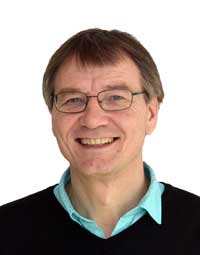Jerry Ståhlberg

Presentation
Jerry Ståhlberg is biochemist, Associate professor/Docent in Molecular Biology and researcher at Department of Molecular Sciences, SLU. We express and purify proteins, characterize biochemically, measure enzyme activities, study 3D structures with X-ray crystallography, and evaluate for various biotechnical purposes. One major focus area concerns cellulases and other enzymes from plant degrading fungi and bacteria that are or can be useful for production of biofuels and other chemicals from lignocellulosic biomass.
Teaching
At undergraduate level I teach general biochemistry and lecture on protein structure and carbohydrates. I have also organized the PhD courses “Processing biomass for biofuels and chemicals”, “Protein structure hands-on workshop” and “Protein crystallization and X-ray data collection”, and lecture occasionally on other PhD and Master courses, internally at SLU and externally, on e.g. protein structure, wood degrading fungi, industrial enzymes and biomass-to-biofuel conversion.
Research
Basic research on protein structure and function using X-ray crystallography plays a central role and we have deposited over 100 structures at the Protein Data Bank (PDB). One focus area concerns carbohydrate active enzymes where we have investigated structure and function of key enzymes from fungi and bacteria that degrade cellulose and other polysaccharides. The results pave the way for improved enzymes and industrial processes for biofuel production through enzyme engineering and genome mining.
Major research topics at present are:
GH7 cellulases – Molecular function and diversity
Fungi are responsible for the majority of plant biomass recycling in terrestrial ecosystems. The most abundant enzymes and major workhorses in cellulose degradation belong to glycoside hydrolase family 7 (GH7). They are also the major components in industrial cellulase cocktails. We have investigated and know rather well how fungal GH7 enzymes look and work. However, GH7s are also present in distantly related organisms (e.g. crustaceans, oomycetes, dinoflagellates). We have earlier determined structure and function of such enzymes in social amoeba (Dictyostelium sp). Now we study GH7 cellulases of symbiotic protozoa (Parabasalia) that live in the gut of termites and enable them to eat wood.
Expansins, loosenins, GH45 – Catalytic mechanism(s)
All plants need proteins called expansins to be able to grow. Expansins are known to loosen up the cell wall so that plant cells can expand several-fold in size after cell division. However, how they do this at molecular level has remained elusive. That is what we want to find out. Expansin homologs with similar structure and catalytic center are used as model proteins, so called loosenins that seem to soften cell walls without hydrolysis, and GH45 enzymes that can cleave glycosidic bonds by hydrolysis. Their interactions with carbohydrates are analyzed in detail using advanced NMR techniques.
Metacaspases – Structure, activation, specificity and regulation
Metacaspases is a diverse family of cysteine proteases and evolutionary ancestors of the well-studied caspases in humans and other animals. Metacaspases are spanning all kingdoms of life, with essential roles in cell death and differentiation, clearance of protein aggregates and aging. However, molecular mechanisms of metacaspase activation, specificity and regulation remain largely unknown, making it difficult to understand metacaspase-guided processes and their potential application in biotechnology and medicine. These questions are addressed in a five-year research program supported by the Knut and Alice Wallenberg foundation, where we are responsible for expression and purification of metacaspases, biochemical characterization, crystallization and structure studies. The programme involves five research groups at SLU and Umeå University, and is lead by Prof. Peter Bozhkov, Dept. Molecular Sciences, SLU.
Cooperation
Jerry Ståhlberg is member of the steering board of two research schools at SLU, Focus on Food and Biomaterials, and Sustainable Biomass Systems.
Background
I am originally from Karlstad, Värmland, in the west of Sweden and came to Uppsala in the 1980’s. At Uppsala University I got a BSc in Biology and PhD in Biochemistry (with Doc. Göran Petterson) on a thesis entitled “Functional organization of cellulases from Trichoderma reesei”. I was then recruited to the structural biology group of Prof. Alwyn Jones, Dept. Molecular Biology, UU, and learned protein crystallization and structure determination with X-ray crystallography, which has been central to my research ever since.
In 1998 I became Docent (Associate professor) in Molecular Biology, moved to SLU (Dept Molecular Biology), received own research grants and got my first PhD student as main supervisor. Since then, I work as researcher, supervisor and teacher at SLU. I was also 20% guest researcher for four years (2009-2013) at Norwegian University of Life Sciences, Ås, Norway (NMBU).
Year 2013 our department (Molecular Biology, SLU) moved from Uppsala Biomedical Centre (BMC) to SLU-Biocenter at Ultuna. We joined first with Dept of Chemistry, and then in 2017 with Dept Microbiology and Dept Food Science, to form the current Dept Molecular Sciences.
Supervision
Main supervisor for 7 graduated PhD students (Ines Muñoz, 2002; Jonas Vasur, 2009; Miao Wu, 2013; Majid Haddad Momeni, 2014; Anna Borisova, 2017; Topi Haataja, 2023; Laura Okmane, 2023). Co-supervisor for 12 graduated and two on-going PhD students. Supervisor or examiner for >20 MSc and BSc projects.
Selected publications
See Jerry Ståhlberg's profile on Google Scholar for up-to-date list of publications and citation records: Click here!